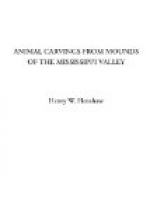The first elephant pipe, which we obtained (Fig. 17) a little more than a year ago, was found some six years before by an illiterate German farmer named Peter Mare, while planting corn on a farm in the mound region, Louisa County, Iowa. He did not care whether it was elephant or kangaroo; to him it was a curious ‘Indian stone,’ and nothing more, and he kept it and smoked it. In 1878 he removed to Kansas, and when he left he gave the pipe to his brother-in-law, a farm laborer, who also smoked it. Mr. Gass happened to hear of it, as he is always inquiring about such things, hunted up the man and borrowed the pipe to take photographs and casts from it. He could not buy it. The man said his brother-in-law gave it to him and as it was a curious thing—he wanted to keep it. We were, however, unfortunate, or fortunate, enough to break it; that spoiled it for him and that was his chance to make some money out of it. He could have claimed any amount, and we would, as in duty bound, have raised it for him, but he was satisfied with three or four dollars. During the first week in April, this month, Rev. Ad. Blumer, another German Lutheran minister, now of Genesee, Illinois, having formerly resided in Louisa County, went down there in company with Mr. Gass to open a few mounds, Mr. Blumer being well acquainted there. They carefully explored ten of them, and found nothing but ashes and decayed bones in any, except one. In that one was a layer of red, hard-burned clay, about five feet across and thirteen inches in thickness at the center, which rested upon a bed of ashes one foot in depth in the middle, the ashes resting upon the natural undisturbed clay. In the ashes, near the bottom of the layer, they found a part of a broken carved stone pipe, representing some bird; a very small beautifully formed copper ‘axe,’ and this last elephant pipe (Fig. 18). This pipe was first discovered by Mr. Blumer, and by him, at our earnest solicitation, turned over to the Academy.
It will be seen from the above that the same gentleman was instrumental in bringing to light the two specimens constituting the present supply of elephant pipes.
The remarkable archaeologic instinct which has guided the finder of these pipes has led him to even more important discoveries. By the aid of his divining rod he has succeeded in unearthing some of the most remarkable inscribed tablets which have thus far rewarded the diligent search of the mound explorer. It is not necessary to speak in detail of these here, or of the various theories to which they have given rise and support, including that of phonetic writing, further than to call attention to the fact that by a curious coincidence one of the tablets contains, among a number of familiar animals, figures which suggest in a rude way the mastodon again, which animal indeed some archaeologists have confidently asserted them to be. The resemblance they bear to that animal is, however, by no means as close as exhibited by the pipe carvings; they are therefore not reproduced here. Both figures differ from the pipes in having tails; both lack trunks, and also tusks.




